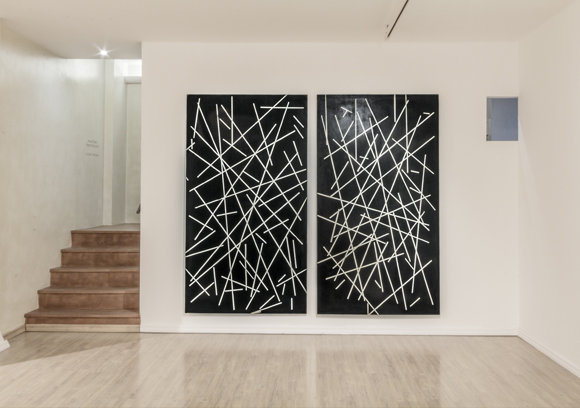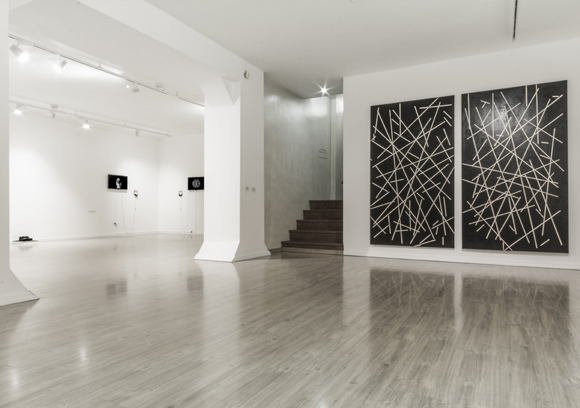| |
|
|
10.
| Martyrs 01 |
| |


2014- 2015, Diptych, acrylic on wood, 220 x 122 cm each
Exhibition view from Permanent Exiles, MAMCO, Geneva, 2015.
Courtesy of the artist and Ceysson & Bénétière, Paris.
'' The emblematic title plays on the semantic variants of this word, whose meaning has transformed through the course of history.
From the ancient Greek word martus, which meant witness, to the definition of a man who sacrifices himself in the name of faith,
up to the present definition in which a martyr is improperly compared to the concept of kamikaze. ''
Wall Street International Art, 2017

Martyrs 01
Exhibition view from Transition State, Officine dell'Immagine, 2017, Milan.
Courtesy of the artist and Ceysson & Bénétière, Paris.

Martyrs 01
Exhibition view from Transition State, Officine dell'Immagine, 2017, Milan.
Courtesy of the artist and Ceysson & Bénétière, Paris.

Martyrs 01
Exhibition view from Permanent Exiles, MAMCO, Geneva, 2015.
Courtesy of the artist and Ceysson & Bénétière, Paris.
|
|
|
|
|
|
Martys est une série d’œuvres composée de panneaux de bois sur lesquels sont peintes sur fond noir une multitude de lignes comme les traces de cicatrices sur un corps. Le titre de l’œuvre, Martyrs, joue sur une double définition du terme. Si son acceptation la plus répandue renvoie aux personnages bibliques qui sont allés jusqu’à se laisser tuer en témoignage de leur foi, un martyr est aussi dans le vocabulaire de l’ébénisterie une cale protégeant des coups de marteaux et de scies.
Un martyr, du grec ancien (martus, « témoin ») est une personne qui va jusqu’à se laisser tuer en témoignage de sa foi, plutôt que d’abjurer. Parfois le mot martyr est utilisé dans le sens plus large de « victime ». Pour l’Islam, on considère le martyr comme un « chahid ». Le sens de ce mot arabe est proche du mot grec « martünos, qui veut dire témoin. Il s’agit évidemment de témoigner de sa foi. Si pour le christianisme, le martyre est également un témoignage de foi qui se fait dans l'amour y compris pour les juges et les bourreaux, le chahid de l'islam peut être un soldat qui meurt en combattant. Cependant, il ne faut donc pas confondre combattant, c'est-à-dire soldat défendant une terre ou une idée, et kamikaze terroriste, c'est-à-dire « semeur de terreur » via des assassinats à grande échelle et voulant imposer ses idées par la force. Toutefois, certaines fatwas affirment le contraire.
Avant de passer à l’étape de peinture, l’artiste découpe d’abord ces lignes droites à l’aide d’une scie électrique. Ces lignes droites protégées par des rubans adhésifs sont révélées une fois que la peinture noire est appliquée sur les panneaux en bois. Ces œuvres offrent en conséquence plusieurs niveaux de lecture engendrés par les deux définitions que leur titre offre. Cette abstraction géométrique, rappelant le suprématisme russe, peut faire écho aux diverses coupures qui ont marqué le corps des martyrs chrétiens. Cependant, le mot martyr a dans le temps historique changé d’acceptations. De nos jours, son utilisation assimilée à celle du kamikaze, désignant « celui qui se tue dans le but de tuer » constitue un contre sens à sa signification originelle.
Sans pouvoir se fixer, l’œil du spectateur navigue d’un panneau à l’autre. Cet effet est accentué par l’aspect conflictuel de ces lignes géométriques. Le spectateur est donc confronté à une surface en tension composée de vides et de pleins sur un fond monochrome noir gravant ainsi l’image de l’œuvre sur la rétine, même en fermant les yeux.
Mounir fatmi, Novembre 2015.
|
|
Martyrs is a series of works composed of wood panels on which a multitude of lines, like scars on a body, are painted on a black background. The title of the work, Martyrs, rests upon the word’s double definition. Its most frequent sense refers to the biblical characters who let themselves be killed as a sign of their faith, but in French a “martyr” is also a term of cabinetmaking designating a block that provides protection against the strikes of a hammer or saw.
A martyr, from the ancient Greek “martus” (witness) is a person who lets him or herself be killed as a sign of faith rather than renounce. Sometimes the word is used in the wider sense of “victim”. In Islam, a martyr is considered a “shahid”. The meaning of this Arabic word is similar to the Grek “marturos”, witness. It’s of course about providing testimony of one’s faith. In Christianity, a martyr is also a demonstration of faith that is conducted with love, including for the victim’s judges and executioners, but the shahid of Islam can be a solider who dies fighting. However, a fighter, i.e. a soldier defending a territory or an idea, shouldn’t be confused with a suicide bomb terrorist, who is a “sower of terror” resorting to large-scale assassinations and wanting to impose his ideas through brute force. Although certain fatwas claim the contrary.
Before the painting begins, the artist cuts these straight lines using an electric saw. The lines protected by adhesive tape are revealed once the black paint is applied on the wood panels. These works therefore offer several degrees of interpretation generated by the two definitions the title conveys. The geometric abstraction, reminiscent of Russian Suprematism, can be linked to the cuts that marked the bodies of Christian martyrs. However, the meaning of the word martyr evolved through the centuries. Today, its most frequent use designating a kamikaze, “he who kills himself in order to kill”, is the reverse of its original meaning.
Unable to settle, the viewer’s eye moves from one panel to another. The effect is accentuated by the conflicted aspect of the geometric lines. The viewer is confronted with a surface full of tension composed of empty and full spaces against a black monochrome background, engraving the image of the work on the retina, even with closed eyes.
Mounir fatmi, November 2015.
Traduit du français par Patrick Haour. |
|
|
|